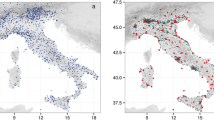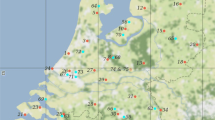Abstract
The dependence of Italian daily electricity demand on cooling degree-days, heating degree-days and solar radiation is investigated by means of a regression model applied to 12 consecutive 2-year intervals in the 1990–2013 period. The cooling and heating degree-days records used in the model are obtained by (i) estimating, by means of a network of 92 synoptic stations and high-resolution gridded temperature climatologies, a daily effective temperature record for all urbanised grid points of a high-resolution grid covering Italy; (ii) using these records to calculate corresponding grid point degree-days records; and (iii) averaging them to get national degree-days records representative of urban areas. The solar radiation record is obtained with the same averaging approach, with grid point solar radiation estimated from the corresponding daily temperature range. The model is based on deterministic components related to the weekly cyclical pattern of demand and to long-term demand changes and on weather-sensitive components related to cooling degree-days, heating degree-days and solar radiation. It establishes a strong contribution of cooling degree-days to the Italian electricity demand, with values peaking in summer months of the latest years up to 211 GWh day−1 (i.e. about 23 % of the corresponding average Italian electricity demand). This contribution shows a strong positive trend in the period considered here: the coefficient of the cooling degree-days term in the regression models increases from the first 2-year period (1990–1991) to the last one (2012–2013) by a factor 3.5, which is much greater than the increase of the Italian total electricity demand.










Similar content being viewed by others
Notes
Special days are Easter period (5-day period, variable date), Liberation Day (April 25), International Workers’ Day (May 1), Republic Day (June 2), summer holiday period (July 27–September 2), All Saints’ Day (November 1), Immaculate Conception (December 8), winter holiday period (December 20–January 9), major strikes (25 events), large-scale blackouts (1 event).
References
Abraha MG, Savage MJ (2008) Comparison of estimates of daily solar radiation from air temperature range for application in crop simulations. Agric For Meteorol 148:401–416
Apadula F, Bassini A, Elli A, Scapin S (2012) Relationships between meteorological variables and monthly electricity demand. Appl Energy 98:346–356
Bessec M, Fouquau J (2008) The non-linear link between electricity consumption and temperature in Europe: a threshold panel approach. Energy Econ 30:2705–2721
Brunetti M, Maugeri M, Monti F, Nanni T (2006) Temperature and precipitation variability in Italy in the last two centuries from homogenised instrumental time series. Int J Climatol 26:345–381
Brunetti M, Lentini G, Maugeri M, Nanni T, Simolo C, Spinoni J (2009) Estimating local records for Northern and Central Italy from a sparse secular temperature network and from 1961–1990 climatologies. Adv Sci Res 3:63–71
Brunetti M, Lentini G, Maugeri M, Nanni T, Simolo C, Spinoni J (2012) Projecting North Eastern Italy temperature and precipitation secular records onto a high resolution grid. Phys Chem Earth 40–41:9–22
Brunetti M, Maugeri M, Nanni T, Simolo C, Spinoni J (2014) High-resolution temperature climatology for Italy: interpolation method intercomparison. Int J Climatol 34:1278–1296
Daly C, Gibson WP, Taylor GH, Johnson GL, Pasteris PA (2002) A knowledge-based approach to the statistical mapping of climate. Clim Res 22:99–113
Daly C (2006) Guidelines for assessing the suitability of spatial climate data sets. Int J Climatol 26:707–721
Daly C, Halbleib M, Smith JI, Gibson WP, Doggett MK, Taylor GH, Curtis J, Pasteris PA (2008) Physiographically-sensitive mapping of temperature and precipitation across the conterminous United States. Int J Climatol 28:2031–2064. doi:10.1002/joc.1688
De Felice M, Alessandri A, Ruti PM (2013) Electricity demand forecasting over Italy: potential benefits using numerical weather prediction models. Electr Power Syst Res 104:71–79
European Commission, Joint Research Centre. 2003. Global Land Cover 2000 database. Available at https://ec.europa.eu/jrc/en/scientific-tool/global-land-cover
Feinberg EA, Genethliou D (2005) Load forecasting. In: Chow JH, Wu FF, Momoh JJ, et al. (eds) Applied mathematics for restructured electric power systems: optimization, control, and computational intelligence. Springer, New York, pp. 269–285
Hekkenberg M, Benders RMJ, Moll HC, Schoot Uiterkamp AJM (2009) Indications for a changing electricity demand pattern: the temperature dependence of electricity demand in the Netherlands. Energ Policy 37:1542–1551
Hor C, Watson SJ, Majithia S (2005) Analyzing the impact of weather variables on monthly electricity demand. IEEE Trans Power Syst 20:2078–2085
Hunt LA, Kuchar L, Swanton CJ (1998) Estimation of solar radiation for use in crop modelling. Agric For Meteorol 91(3–4):293–300
Iqbal M (1983) An introduction to solar radiation. Academic Press, New York
Lee CC, Chiu YB (2011) Electricity demand elasticities and temperature: evidence from panel smooth transition regression with instrumental variable approach. Energy Econ 33:896–902
Manera M, Marzullo A (2005) Modelling the load curve of aggregate electricity consumption using principal components. Environ Model Softw 20:1389–1400
Marvuglia A, Messineo A (2012) Using recurrent artificial neural networks to forecast household electricity consumption. Energy Procedia 14:45–55
Masterton JM, Richardson FA (1979) Humidex, a method of quantifying human discomfort due to excessive heat and humidity, CLI 1-79. Environment Canada, Atmospheric Environment Service, Downsview
Mitchell TD, Jones PD (2005) An improved method of constructing a database of monthly climate observations and associated high-resolution grids. Int J Climatol 25:693–712
Moral-Carcedo J, Vicéns-Otero J (2005) Modelling the non-linear response of Spanish electricity demand to temperature variations. Energy Econ 27:477–494
New M, Hulme M, Jones PD (2000) Representing twentieth century space-time variability. Part 2: development of 1901–96 monthly grids of surface climate. J Clim 13:2217–2238
Pardo A, Meneu V, Valor E (2002) Temperature and seasonality influences on Spanish electricity load. Energy Econ 24:55–60
Picard RR, Cook RD (1984) Cross validation of regression models. J Am Stat Assoc 79(387):575–583
Psiloglou BE, Giannakopoulos C, Majithia S, Petrakis M (2009) Factors affecting electricity demand in Athens, Greece and London, UK: a comparative assessment. Energy 34:1855–1863
Radhi H, Sharples S (2013) Quantifying the domestic electricity consumption for air-conditioning due to urban heat islands in hot arid regions. Appl Energy 112:371–380
Simolo C, Brunetti M, Maugeri M, Nanni T, Speranza A (2010) Understanding climate change-induced variations in daily temperature distributions over Italy. J Geophys Res Atmos 115:D22110. doi:10.1029/2010JD014088
Taylor JW, Buizza R (2003) Using weather ensemble predictions in electricity demand forecasting. Int J Forecast 19:57–70
USGS (United States Geological Survey). 1996. GTOPO30 Documentation. Available at http://eros.usgs.gov/#/Find_Data/Products_and_Data_Available/gtopo30_info
Acknowledgments
The present work was partly funded by the Research Fund for the Italian Electrical System under the Contract Agreement between RSE S.p.A. and the Ministry of Economic Development—General Directorate for Nuclear Energy, Renewable Energy and Energy Efficiency, stipulated on July 29, 2009, in compliance with the Decree of March 19, 2009, and partly by the EU FP7 project ECLISE (265240).
We would like also to thank the Italian transmission system operator TERNA for its valuable collaboration in providing electricity consumption data.
We also kindly acknowledge Prof. Ruth Löwenstein for her help in improving the language of the paper.
Author information
Authors and Affiliations
Corresponding author
Rights and permissions
About this article
Cite this article
Scapin, S., Apadula, F., Brunetti, M. et al. High-resolution temperature fields to evaluate the response of Italian electricity demand to meteorological variables: an example of climate service for the energy sector. Theor Appl Climatol 125, 729–742 (2016). https://doi.org/10.1007/s00704-015-1536-5
Received:
Accepted:
Published:
Issue Date:
DOI: https://doi.org/10.1007/s00704-015-1536-5




